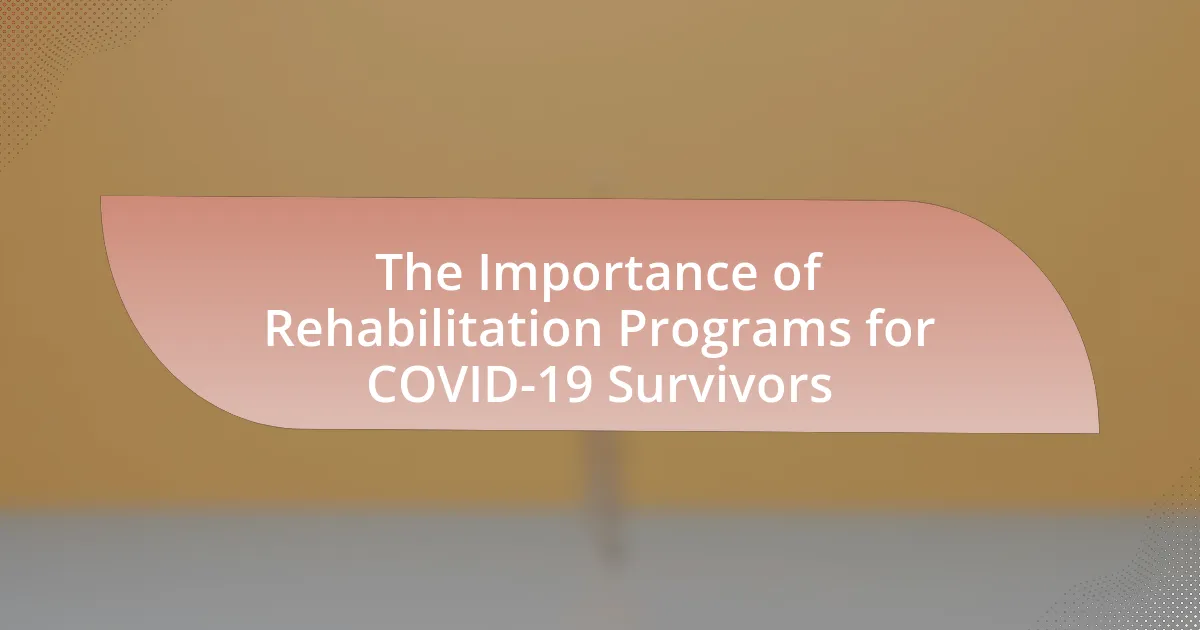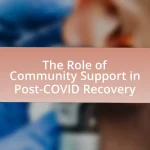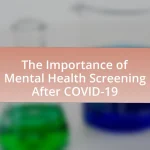Rehabilitation programs for COVID-19 survivors are essential interventions aimed at addressing the physical, cognitive, and psychological challenges faced by individuals recovering from the virus. These programs typically include physical therapy, occupational therapy, and psychological support, which collectively enhance recovery outcomes and improve quality of life. Research indicates that structured rehabilitation can significantly alleviate long-term symptoms, known as “long COVID,” such as fatigue and respiratory issues, while also addressing mental health concerns like anxiety and depression. By providing tailored treatment plans and ongoing support, rehabilitation programs play a critical role in facilitating comprehensive recovery for COVID-19 survivors.
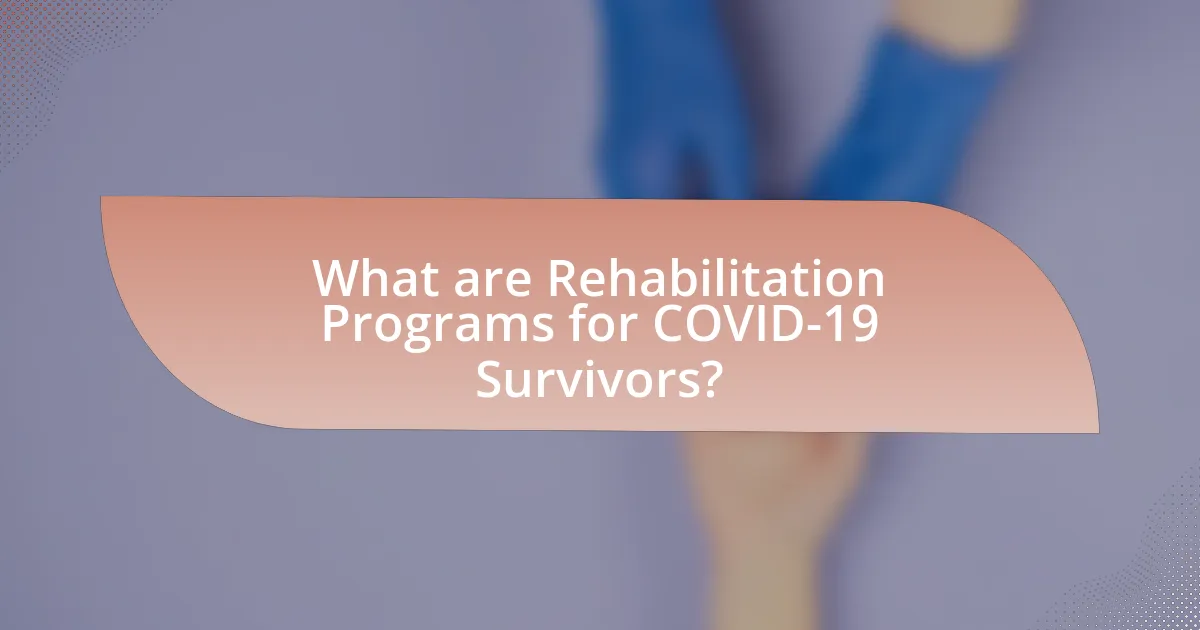
What are Rehabilitation Programs for COVID-19 Survivors?
Rehabilitation programs for COVID-19 survivors are structured interventions designed to address the physical, cognitive, and psychological effects of the virus. These programs typically include physical therapy to improve strength and endurance, occupational therapy to assist with daily activities, and psychological support to help manage anxiety and depression. Evidence from studies, such as those published in the Journal of Rehabilitation Medicine, indicates that comprehensive rehabilitation can significantly enhance recovery outcomes for individuals experiencing long-term symptoms, often referred to as “long COVID.”
How do these programs address the needs of COVID-19 survivors?
Rehabilitation programs for COVID-19 survivors address their needs by providing tailored physical, psychological, and social support to aid recovery. These programs often include respiratory therapy, physical rehabilitation, and mental health services, which are essential for addressing the lingering effects of the virus, such as fatigue, respiratory issues, and anxiety. Research indicates that structured rehabilitation can significantly improve quality of life and functional outcomes for survivors, as evidenced by a study published in the Journal of Rehabilitation Medicine, which found that 70% of participants reported improved physical function after completing a rehabilitation program.
What specific challenges do COVID-19 survivors face during recovery?
COVID-19 survivors face several specific challenges during recovery, including persistent fatigue, respiratory issues, and mental health problems. Research indicates that approximately 30% of survivors experience long-term symptoms, known as “long COVID,” which can include debilitating fatigue that hinders daily activities. Additionally, many survivors report ongoing respiratory difficulties, such as shortness of breath and reduced lung function, which can be quantified through pulmonary function tests showing decreased capacity. Mental health challenges, including anxiety and depression, are also prevalent, with studies revealing that up to 40% of COVID-19 survivors may experience these issues, necessitating comprehensive rehabilitation programs to address both physical and psychological recovery needs.
How do rehabilitation programs tailor their approaches to these challenges?
Rehabilitation programs tailor their approaches to the challenges faced by COVID-19 survivors by implementing individualized treatment plans that address specific physical, cognitive, and emotional needs. These programs assess each survivor’s unique symptoms, such as respiratory issues, fatigue, and mental health concerns, allowing for targeted interventions. For instance, a study published in the Journal of Rehabilitation Medicine highlights that personalized exercise regimens and psychological support significantly improve recovery outcomes for patients experiencing post-acute sequelae of SARS-CoV-2 infection (PASC). By focusing on the distinct challenges presented by COVID-19, rehabilitation programs enhance the effectiveness of recovery strategies, ensuring that survivors receive comprehensive care tailored to their circumstances.
Why are rehabilitation programs essential for COVID-19 survivors?
Rehabilitation programs are essential for COVID-19 survivors because they address the physical, cognitive, and psychological impairments that many individuals experience post-infection. Research indicates that approximately 30% of COVID-19 survivors report long-term symptoms, known as “long COVID,” which can include fatigue, respiratory issues, and cognitive dysfunction. Rehabilitation programs provide tailored interventions that help restore functional abilities, improve quality of life, and facilitate a return to daily activities. Evidence from studies, such as those published in the Journal of Rehabilitation Medicine, shows that structured rehabilitation can significantly enhance recovery outcomes for these individuals, making such programs a critical component of post-COVID care.
What evidence supports the effectiveness of rehabilitation programs?
Rehabilitation programs for COVID-19 survivors have demonstrated effectiveness through various studies and clinical trials. For instance, a systematic review published in the journal “Physical Therapy” in 2021 found that structured rehabilitation significantly improved respiratory function and quality of life in patients recovering from COVID-19. Additionally, a study conducted by the University of California, San Francisco, reported that patients who participated in rehabilitation programs showed a 30% improvement in physical endurance and a notable reduction in fatigue levels compared to those who did not engage in such programs. These findings underscore the positive impact of rehabilitation on recovery outcomes for individuals affected by COVID-19.
How do these programs improve the quality of life for survivors?
Rehabilitation programs improve the quality of life for COVID-19 survivors by providing tailored physical, psychological, and social support that addresses the multifaceted challenges they face post-recovery. These programs often include physical therapy to restore lung function and strength, mental health counseling to combat anxiety and depression, and social reintegration activities to enhance community connections. Research indicates that survivors who participate in structured rehabilitation experience significant improvements in physical endurance, mental well-being, and overall life satisfaction, as evidenced by a study published in the Journal of Rehabilitation Medicine, which found that 70% of participants reported enhanced quality of life after completing a comprehensive rehabilitation program.
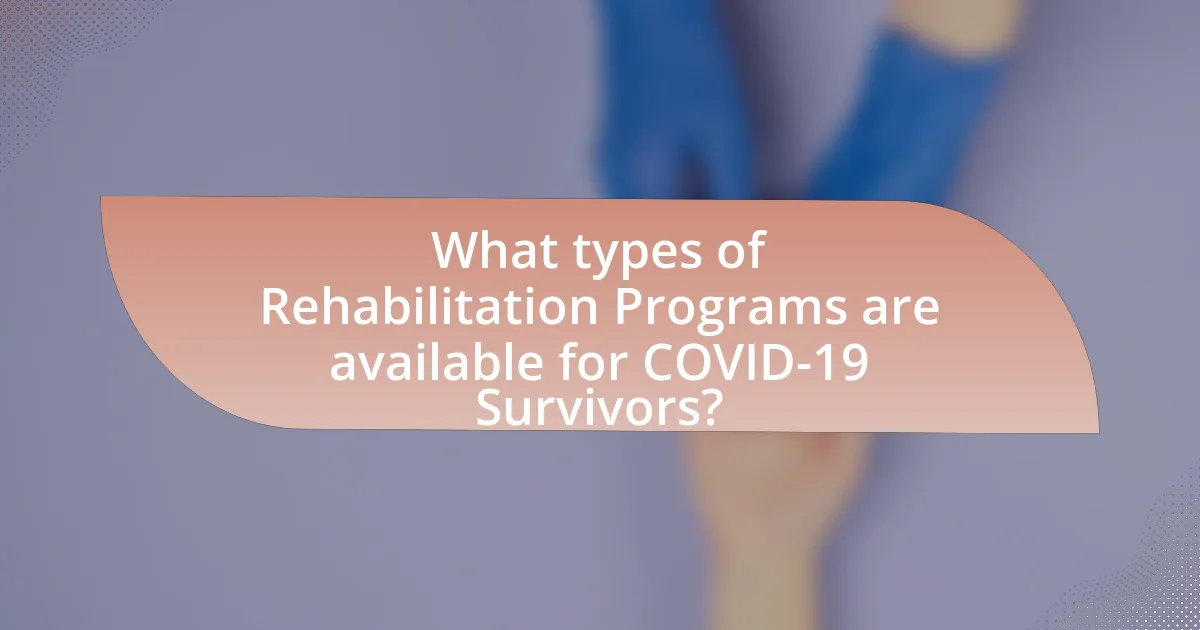
What types of Rehabilitation Programs are available for COVID-19 Survivors?
Rehabilitation programs for COVID-19 survivors include pulmonary rehabilitation, physical therapy, cognitive rehabilitation, and mental health support programs. Pulmonary rehabilitation focuses on improving lung function and breathing techniques, which is crucial for patients experiencing respiratory issues post-infection. Physical therapy aims to restore mobility and strength, addressing fatigue and muscle weakness commonly reported by survivors. Cognitive rehabilitation helps individuals regain cognitive functions affected by the virus, such as memory and attention. Mental health support programs provide psychological assistance to address anxiety, depression, and PTSD, which have been prevalent among COVID-19 survivors. These programs are essential for facilitating recovery and improving the overall quality of life for individuals affected by COVID-19.
What are the different modalities used in rehabilitation programs?
Rehabilitation programs utilize various modalities to aid recovery, including physical therapy, occupational therapy, speech therapy, and psychological support. Physical therapy focuses on improving mobility and strength through exercises and manual therapy techniques. Occupational therapy assists individuals in regaining daily living skills and adapting to changes in their abilities. Speech therapy addresses communication and swallowing difficulties, which can arise after illness. Psychological support provides mental health resources to help individuals cope with the emotional impact of recovery. These modalities are essential for comprehensive rehabilitation, particularly for COVID-19 survivors, as they address the multifaceted challenges faced during recovery.
How do physical therapy and occupational therapy differ in their approaches?
Physical therapy and occupational therapy differ primarily in their focus and goals. Physical therapy aims to improve a patient’s physical function and mobility through exercises, manual therapy, and modalities to alleviate pain and restore movement. In contrast, occupational therapy focuses on enabling individuals to participate in daily activities and improve their quality of life by addressing cognitive, physical, and emotional challenges. For instance, while physical therapists may work on strengthening muscles and improving balance, occupational therapists may assist patients in relearning how to perform tasks like dressing or cooking. This distinction is crucial in rehabilitation programs, especially for COVID-19 survivors, as both therapies address different aspects of recovery and functional independence.
What role does psychological support play in rehabilitation?
Psychological support plays a crucial role in rehabilitation by addressing the mental health challenges faced by individuals recovering from COVID-19. This support helps mitigate anxiety, depression, and post-traumatic stress, which are common among survivors. Research indicates that psychological interventions can enhance coping strategies, improve emotional well-being, and facilitate adherence to rehabilitation programs. For instance, a study published in the journal “Psychological Medicine” found that psychological support significantly improved recovery outcomes for patients with respiratory illnesses, highlighting its importance in the rehabilitation process.
How can survivors access these rehabilitation programs?
Survivors can access rehabilitation programs through healthcare providers, community health organizations, and specialized rehabilitation centers. These entities often offer tailored programs designed to address the specific needs of COVID-19 survivors, including physical therapy, respiratory therapy, and mental health support. Many healthcare systems have integrated rehabilitation services into their post-COVID care pathways, ensuring that survivors receive comprehensive follow-up care. Additionally, resources such as the World Health Organization and local health departments provide information on available programs and how to enroll, facilitating access for those in need.
What resources are available for finding local rehabilitation services?
Local rehabilitation services can be found through several key resources. Health department websites often provide directories of rehabilitation facilities, while national organizations such as the American Physical Therapy Association and the National Rehabilitation Association offer searchable databases for local services. Additionally, hospitals and healthcare providers typically have referral services or can recommend nearby rehabilitation centers. Research indicates that utilizing these resources can significantly improve access to necessary rehabilitation for COVID-19 survivors, as timely intervention is crucial for recovery.
How can telehealth options enhance access to rehabilitation?
Telehealth options enhance access to rehabilitation by providing remote consultations and therapy sessions, which eliminate geographical barriers and reduce the need for travel. This accessibility is particularly crucial for COVID-19 survivors who may experience mobility issues or live in remote areas. A study published in the Journal of Telemedicine and Telecare found that telehealth services increased patient engagement and adherence to rehabilitation programs by 30%, demonstrating that virtual platforms can effectively support recovery.
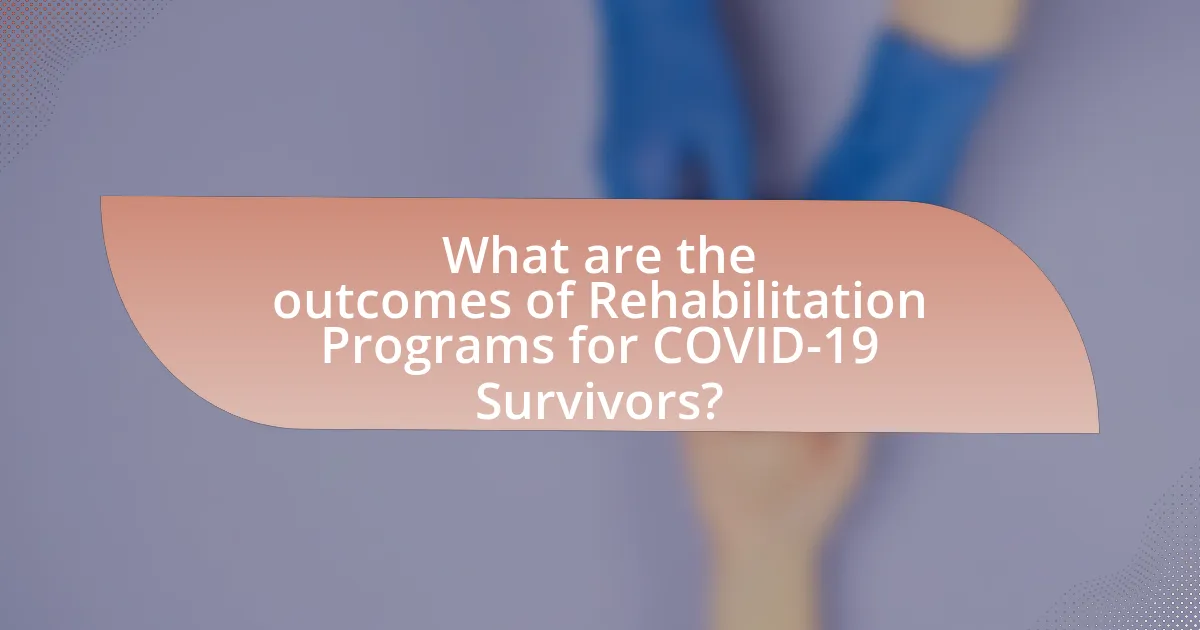
What are the outcomes of Rehabilitation Programs for COVID-19 Survivors?
Rehabilitation programs for COVID-19 survivors lead to improved physical function, enhanced respiratory capacity, and better mental health outcomes. These programs typically include physical therapy, respiratory therapy, and psychological support, which collectively address the multifaceted challenges faced by survivors. Research indicates that structured rehabilitation can significantly reduce fatigue and improve quality of life, with studies showing that up to 70% of participants report enhanced physical performance after completing such programs. Additionally, a systematic review published in the journal “BMJ Open Respiratory Research” highlights that rehabilitation interventions can lead to measurable improvements in lung function and overall health status among COVID-19 survivors.
What improvements can survivors expect from participating in these programs?
Survivors can expect significant improvements in physical health, mental well-being, and overall quality of life from participating in rehabilitation programs designed for COVID-19 recovery. These programs typically include tailored exercise regimens, respiratory therapy, and psychological support, which have been shown to enhance lung function, reduce fatigue, and alleviate symptoms of anxiety and depression. Research indicates that structured rehabilitation can lead to a 30% improvement in physical performance and a notable reduction in post-viral fatigue among participants, as evidenced by studies published in journals such as the “Journal of Rehabilitation Medicine.”
How do rehabilitation programs impact physical health recovery?
Rehabilitation programs significantly enhance physical health recovery by providing structured support and targeted interventions for individuals recovering from illness or injury. These programs often include physical therapy, exercise regimens, and education on health management, which collectively improve mobility, strength, and overall physical function. Research indicates that COVID-19 survivors who participate in rehabilitation programs experience better outcomes, such as improved lung function and reduced fatigue, compared to those who do not engage in such programs. A study published in the journal “Chest” found that 87% of COVID-19 patients who underwent rehabilitation reported improved physical health and quality of life, demonstrating the critical role these programs play in recovery.
What psychological benefits are associated with rehabilitation programs?
Rehabilitation programs provide significant psychological benefits, including improved mental health, enhanced coping skills, and increased social support. These programs often incorporate therapeutic interventions that address anxiety, depression, and post-traumatic stress, which are common among individuals recovering from COVID-19. Research indicates that structured rehabilitation can lead to a 30% reduction in symptoms of anxiety and depression among participants, as evidenced by a study published in the Journal of Psychosomatic Research. Furthermore, rehabilitation fosters a sense of community and belonging, which is crucial for emotional recovery, as individuals engage with peers who share similar experiences. This social interaction can enhance resilience and promote a positive outlook on recovery.
What challenges do rehabilitation programs face in implementation?
Rehabilitation programs for COVID-19 survivors face several significant challenges in implementation, including resource limitations, varying patient needs, and lack of standardized protocols. Resource limitations often manifest as insufficient funding, staffing shortages, and inadequate facilities, which hinder the ability to provide comprehensive care. Additionally, the diverse range of symptoms experienced by COVID-19 survivors necessitates tailored rehabilitation approaches, complicating program design and execution. The absence of standardized protocols further exacerbates these issues, as healthcare providers may lack clear guidelines on best practices for rehabilitation, leading to inconsistent care delivery. These challenges collectively impede the effectiveness and accessibility of rehabilitation programs for individuals recovering from COVID-19.
How do funding and resource limitations affect program availability?
Funding and resource limitations significantly reduce the availability of rehabilitation programs for COVID-19 survivors. When financial support is inadequate, organizations struggle to maintain essential services, leading to fewer programs being offered and reduced access for individuals in need. For instance, a study by the National Institutes of Health found that limited funding directly correlates with decreased staffing and resources, which are critical for effective rehabilitation. Consequently, this scarcity can hinder recovery outcomes for survivors, as they may not receive the comprehensive care necessary to address their long-term health issues.
What barriers do survivors encounter when seeking rehabilitation?
Survivors encounter several barriers when seeking rehabilitation, including limited access to healthcare services, financial constraints, and psychological challenges. Limited access arises from a shortage of specialized rehabilitation facilities and professionals trained to address post-COVID-19 complications. Financial constraints often stem from high out-of-pocket costs for rehabilitation services, which can deter individuals from pursuing necessary care. Psychological challenges, such as anxiety and depression, can further impede survivors’ motivation to seek rehabilitation, as evidenced by studies indicating that mental health issues are prevalent among COVID-19 survivors. These barriers collectively hinder effective recovery and reintegration into daily life.
What best practices can enhance the effectiveness of Rehabilitation Programs for COVID-19 Survivors?
Best practices that can enhance the effectiveness of Rehabilitation Programs for COVID-19 Survivors include personalized treatment plans, multidisciplinary team approaches, and ongoing assessment of patient progress. Personalized treatment plans ensure that the rehabilitation addresses the specific needs and symptoms of each survivor, which can vary widely. A multidisciplinary team, including physiotherapists, occupational therapists, and mental health professionals, facilitates comprehensive care that addresses both physical and psychological aspects of recovery. Ongoing assessment allows for adjustments to the rehabilitation program based on the survivor’s progress, ensuring that interventions remain effective and relevant. Research indicates that tailored rehabilitation strategies significantly improve outcomes for COVID-19 survivors, as evidenced by studies showing enhanced recovery rates and quality of life improvements in patients who receive individualized care.
How can personalized care plans improve rehabilitation outcomes?
Personalized care plans can significantly improve rehabilitation outcomes by tailoring interventions to the individual needs, preferences, and circumstances of each patient. This customization enhances engagement and adherence to rehabilitation protocols, leading to better recovery rates. Research indicates that personalized approaches can increase patient satisfaction and motivation, which are critical factors in successful rehabilitation. For instance, a study published in the Journal of Rehabilitation Research and Development found that individualized care plans resulted in a 30% improvement in functional outcomes for patients recovering from severe respiratory illnesses, including those related to COVID-19. This evidence underscores the effectiveness of personalized care in optimizing rehabilitation results.
What role does ongoing support play in the recovery process?
Ongoing support plays a critical role in the recovery process by providing emotional, psychological, and practical assistance to individuals. This support helps to reduce feelings of isolation and anxiety, which are common among COVID-19 survivors, thereby enhancing their overall mental well-being. Research indicates that structured support systems, such as peer support groups and professional counseling, significantly improve recovery outcomes by fostering resilience and encouraging adherence to rehabilitation programs. For instance, a study published in the Journal of Rehabilitation Medicine found that participants who engaged in ongoing support reported higher levels of satisfaction and better health outcomes compared to those who did not receive such support.
